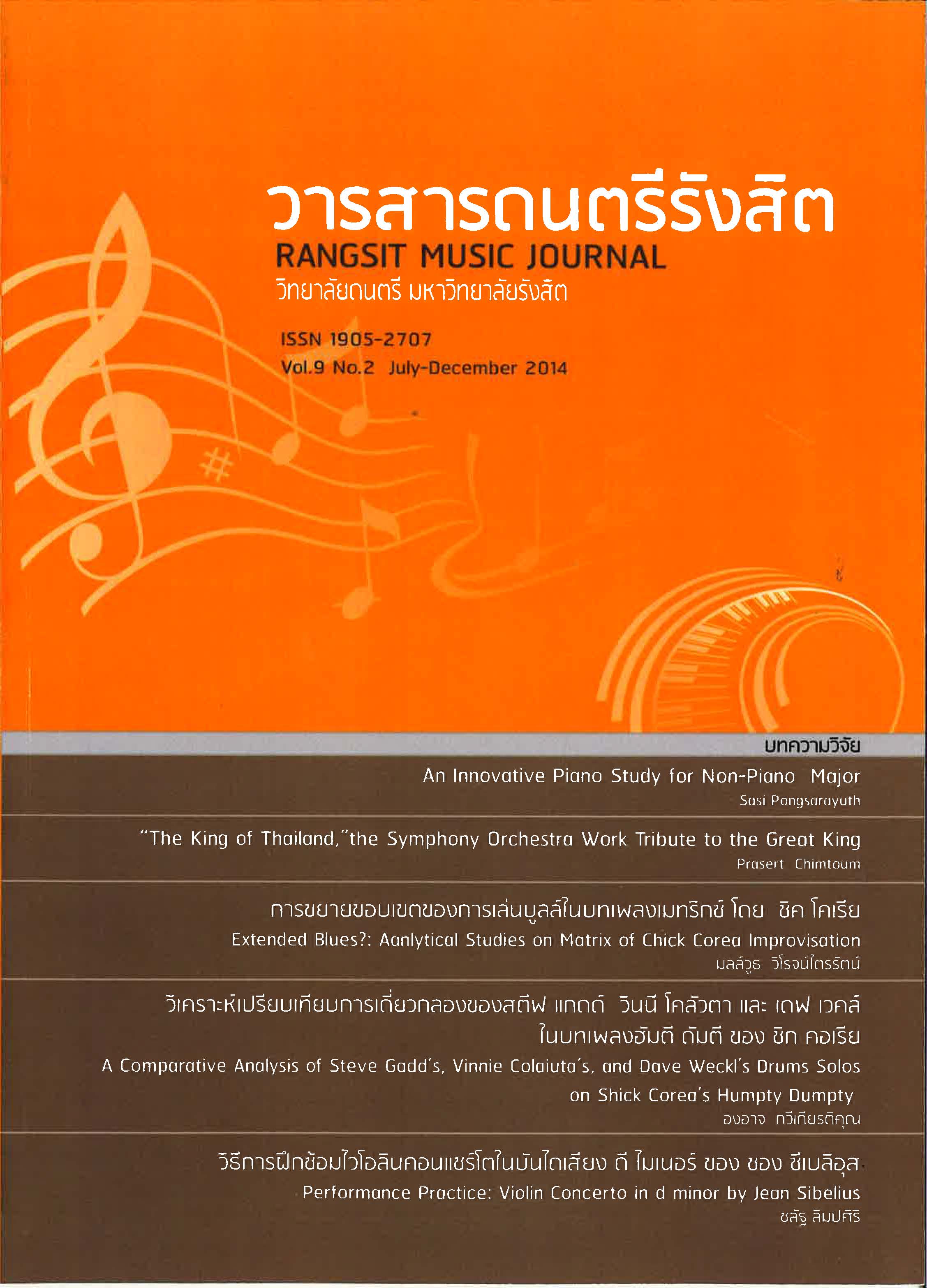Extended Blues? : Analytical Studies on Matrix of Chick Corea Improvisation
Abstract
The purpose of this study is to analyze Chick Corea's entended improvisation on his Blues "Matrix" has pushed the boundaries of Blues style in his number "Matrix" by looking into the details of rhythm, melodic lines, harmony, modes and other key elements found in the piece. The research has speculated that rhythm-wise, Corea used rhythmic permutations (playing the same groupings over different positions in a measure) to vary his improvising materials which can be further developed. Melody-wise, Corea relied heavily on the four-note groupings that being derived from different scales such as pentatonic, diminished scale and chromatic. The melodic variations also include sequences which created uniformity throughout his passages despite using nonchord tones. Harmony-wise, Corea generously used fourth intervals (both perfect and augmented) and quartal chords in his left hand. His chord progressions applied extended triads on major chords between his left and right hands in order to create extended harmony which added interesting colors to the melodies, pushing the boundaries of traditional harmony and yielding unforeseen musical materials to develop at the greater lengths.
References
2. เจตนิพิฐ สังข์วิจิตร. "วิเคราะห์เปรียบเทียบการอิมโพรไวส์ของแพ็ท เมทินี และไมค์ สเทิร์น ในบทเพลงไจแอนท์สเต็ปส์ ของจอหน์ โคลเทรน." วิทยานิพนธ์ศิลปมหาบัณฑิต, สาขาวิชาดนตรี วิทยาลัยดนตรี, มหาวิทยาลัยรังสิต, 2555.
3. ณัชชา โสคติยานุรักษ์. พจนานุกรมศัพท์ดุริยางคศิลป์. พิมพ์ครั้งที่ 3. กรุงเทพฯ: เกศกะรตั, 2552.
4. เด่น อยู่ประเสริฐ. เอกสารประกอบการสอนแยกและเรียบเรียงเสียงประสาน 1. พิมพ์ครั้งที่ 2. ปทุมธานี: สำนักพิมพ์มหาวิทยาลัยรังสิต, 2551.
5. ______. "เดอะ เมทริกซ์: F บลูส์หรืออะไร?." แจ๊สซีน 1 (มิถุนายน - กรกฎาคม 2549): 65-66.
6. ______. "โครงสร้างของดนตรีแจ๊ส (Jazz Structure)." วารสารดนตรีรังสิต 5, 1 (มกราคม 2553): 31-42.
7. Gridley, Mark C. Jazz Styles: History and Analysis. 10th ed. Englewood Cliffs, NJ: Prentice Hall, 2009.
8. Mehegan, John. Jazz Improvisation II:Jazz Rhythm and The Improvised Line. New York: Waston Guptill, 1962.
9. ______. Jazz Improvisation IV: Comtemporary Styles. New York: Waston-Guptill, 1965.
10. Porter, Lewis, Micheal Ullman, and Edward Hazell. Jazz From Its Origins to The Present. Englewood Cliffs, NJ: Prentice Hall,1993.
11. Reeves, Scott D. Creative Jazz Improvisation. Englewood Cliffs, NJ: Prentice Hall, 2007.
12. Valerio, John. Post-Bop Jazz Piano. Victoria, AU: Hal Leonard, 2005.







